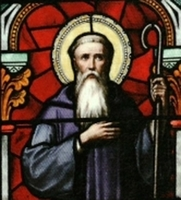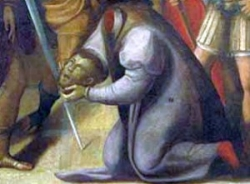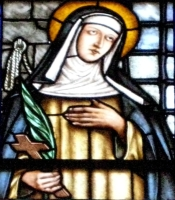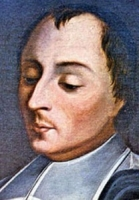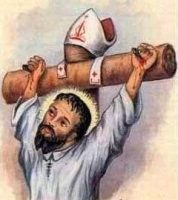St. Agapius
Feastday: April 29
Death: 259
Martyr and probably a bishop, caught up in the persecutions of Emperor Valerian. Agapius and a companion, Secundus, by tradition Spaniards, were exiled by the Romans to Africa. There they were martyred with Emilian, Tertulla, Antonia, and others at Citra.
Saint Catherine of Siena
சியன்னா நகர புனித கத்ரீன்
சியன்னா நகர புனித கத்ரீன் (25 மார்ச் 1347, சியன்னா - 29 ஏப்ரல் 1380, உரோம்) ஒரு தொமினிக்கன் மூன்றாம் சபையின் உறுப்பினரும், இறையியலாளரும், மெய்யியலாளரும் ஆவார். இவர் அவிஞ்ஞோன் நகரில் தங்கியிருந்த திருத்தந்தை பதினொன்றாம் கிரகோரி உரோமை நகருக்குத் திரும்பிச் செல்ல மிக முக்கிய காரணியாய் இருந்தார். 1970-இல் இவர் கத்தோலிக்க திருச்சபையின் மறைவல்லுநராக அறிவிக்கப்பட்டார். அசிசியின் புனித பிரான்சிசோடு இவரும் இத்தாலியின் பாதுகாவலராக கருதப்படுகின்றார்.
வாழ்க்கைக் குறிப்பு
சியன்னா நகரில் உள்ள கத்ரீனின் வீடு
இவரின் இயற்பெயர் கத்ரோனா பெனின்கசா. இவர் இத்தாலியில் உள்ள சியன்னா என்னும் ஊரில், கியாகோமோ டி பெனின்கசாவுக்கும், லாப்பா பியகென்டியுக்கும் பிறந்தவர்.[1] இவர் பிறந்த வருடமான 1347-இல் கறுப்புச் சாவினால் மிகவும் பாதிக்கப்பட்டிருந்தது.
கத்ரீனுக்கு ஐந்து அல்லது ஆறு அகவையின் போது முதல் காட்சி கிடைத்தது. அதில் இயேசு தன்னை ஆசிர்வதித்தார் எனவும், தன்னைப் பார்த்து சிரித்தார் எனவும். இக்காட்சியின் முடிவில் பரவச நிலையை அடைந்தார் எனவும் கூறியுள்ளார். ஏழு வயதில் இவர் கற்பு வார்த்தைப்பாடை அளித்தார்.
இவரின் மூத்த சகோதரியின் மறைவுக்கு பின்னர், மூத்த சகோதரியின் கணவரை மணக்க இவரின் பெற்றோர், இவரைகட்டாயப்படுத்தினர். இதனால் தன் பெற்றோர் மனம் மாறும் வரை உண்ணா நோன்பிருந்தார். அப்போது தன் அழகை குறைக்க தன் நீண்ட கூந்தலை வெட்டினார். புனித தோமினிக் அவரின் கனவில் தோன்றி அவரைத் தேற்றினார்.
கத்ரீன் தொமினிக்கன் சபையில் சேர்ந்தார். இதனை அச்சபை உறுப்பினர்கள் பலர் எதிர்த்தனர். ஏனெனில் அதுவரை விதவைகள் மட்டுமே அச்சபையில் சேர அனுமதி இருந்தது.
1366-இல் அவருக்கு கிடைத்த பரவச நிலையில் இயேசு தன்னை ஆன்மீக முறையில் மணந்து கொண்டதாக இவர் நம்பினார். அப்போது கிறிஸ்து இவரை, மறைந்த வாழ்வினை விடுத்து, பொது வாழ்க்கைக்கு போக சொன்னதாக இவர் தன் ஆன்ம வழிகாட்டியிடம் கூறியுள்ளார். இவர் நோயுற்றோருக்கு உதவினார். இவரின் தொண்டு உள்ளம் சிலரைக் கவர்ந்ததால், மேலும் சிலரும் தொண்டு புரிவதில் இவரோடு இணைந்தனர். இதனால் 1374-இல் தொமினிக்கன் சபைத் தலைவர்களால் பிளாரன்சு நகரில் தப்பறைக்கொள்கைகளுக்காக விசாரிக்கப்பட்டு, குற்றமற்றவராக அறிவிக்கப்பட்டார். இதன் பின் வடக்கு மற்றும் மத்திய இத்தாலியில் பயணம் செய்து, கடவுளை அன்பு செய்து புரட்சிபடைக்க மக்களை ஊக்குவித்தார்.[3]
1370-இன் முன் பகுதில் அவர் பலருக்கு கடிதம் எழுதினார்.[4] இக்கடிதங்களினால் இத்தாலியின் பெருங்குடியினர் மத்தியில் அமைதி பிறக்க அரும்பாடுபட்டார். இவர் திருத்தந்தை பதினொன்றாம் கிரகோரியுடன் மிக நீண்ட கடித தொடர்பு வைத்திருந்தார். அதில் அவர் திருத்தந்தை நாடுகளின் மேலாளர்களையும், குருக்களையும் கண்டித்து வழிநடத்த அறிவுறுத்தினார்.
ஜூன் 1376-இல் இவர் தாமாகவே முன்வந்து திருத்தந்தை நாடுகளில் அமைதி கொணர முயன்றார். அது பயன் அளிக்காததால், திருத்தந்தை பதினொன்றாம் கிரகோரியை மீண்டும் அவிஞ்ஞோனிலிருந்து உரோமைக்கு 1377, ஜனவரியில் திரும்பி வரச் செய்தார். இத்திருத்தந்தையின் மறைவுக்குப் பின், யாரைத் திருத்தந்தையாக ஏற்பது என்பது குறித்து மேற்கு திருச்சபையில் பிளவு ஏற்பட்டது ("பெரும் பிளவு" அல்லது Western Schism of 1378). அப்போது இவர் திருத்தந்தை ஆறாம் அர்பனுக்கு துணை புரிய உரோம் நகரில் சென்று தங்கினார். அங்கேயே சாகும் வரை இருந்தார். இந்தப் பெரும் பிளவினால் ஏற்பட்ட துன்பங்களினால் அவர் சாகும் வரை வாடினார்.
புனித கத்ரீனின் கடிதங்கள் ஆரம்பகால டஸ்கான் இலக்கியத்தின் சிறந்த படைப்புகளில் ஒன்றாக கருதப்படுகிறது. இக்கடிதங்களுல் 300 கிடைத்து உள்ளது. திருத்தந்தைக்கான தனது கடிதங்களில், அவர் அடிக்கடி அவரை papa (இத்தாலிய மொழியில் "திருத்தந்தை") என்று அன்பாக குறிப்பிடப்படுகின்றார். ஆன்ம குருக்கள், கபுவாவின் ரேமண்ட், பிரான்ஸ் மற்றும் ஹங்கேரி அரசர்கள், கூலிப்படையினனான ஜான் ஹாக்வுட், நேபிள்ஸ் ராணி, மிலனின் விஸ்கோன்தி (Visconti) குடும்ப உறுப்பினர்கள், மற்றும் பலருக்கு இக்கடிதங்கள் எழுதப்பட்டன. அவரது கடிதங்கள் சுமார் மூன்றில் ஒரு பங்கு பெண்களுக்கு எழுதப்பட்டது.
இவரின் The Dialogue of Divine Providence, என்னும் நூல், 1377 - 1378 இவர் சொல்லச் சொல்ல எழுதப்பட்டதாகும். பெரும்பாலும் படிப்பறிவில்லாதவராக கருதப்பட்டாலும், லத்தீன் மற்றும் இத்தாலிய மொழிகளை படிக்கும் திறன் இருந்ததாக அவரின் ஆன்ம குரு ரேமண்ட் கூறியுள்ளார், அவரது எழுத்துக்கள் பெரும்பாலும் மற்றவரால் சொல்லச் சொல்ல எழுதப்பட்டது என்றாலும் அவருக்கு எழுதத் தெரியும் என்றும் அவர் கூறியுள்ளார்.
இறப்பு
Libro della divina dottrina, c. 1475
சான் தோமினோ பேராலயம், சியன்னா. இங்கே சியன்னா நகர புனித கத்ரீனின் மீபொருட்களுள் சில வைக்கப்பட்டுள்ளது
புனித கத்ரீனின் முப்பத்தி மூன்று வயதில் ரோம் நகரின் வசந்த காலத்தில், 1380-ஆம் ஆண்டு இறந்தார்.
கத்ரீனின் உணவு குறைவாகவே உண்டார். அதற்கு பதிலாக அவர் தினசரி நற்கருணை பெற்றார். இதனால் குருக்கள் மற்றும் அவரது சொந்த சபை சகோதரிகள் கண்களிலும் ஆரோக்கியமற்று தோற்றமளித்தார். இவரின் ஆன்ம குரு, ரோமண்டு, இவரை சரியான உணவு உண்ண அறிவுறித்திய போது, தன்னால் உண்ண முடியவில்லை எனவும், அவ்வாறு உண்டால் கடுமையான வயிற்று வலியால் அவதி உறுவதாகவும் கூறினார் என்பர்.
மினெர்வா மேல் புனித மரியா கோவிலின் அருகில் உள்ள கல்லறையில் இவர் அடக்கம் செய்யப்பட்டார். அங்கே பல புதுமைகள் நிகழ்ந்ததாக மக்கள் கூறியதால் இவரின் உடல் கோயிலினுள் அடக்கம் செய்யப்பட்டது.[5] இவரின் தலை, உடலிலிருந்து பிரித்து எடுக்கப்பட்டு சியன்னா நகரில் உள்ள தொமினிக்கன் ஆலயத்தில் வைக்கப்பட்டுள்ளது.[6][7]
மினெர்வா மேல் புனித மரியா கோவிலில் உள்ள கத்ரீனின் கல்லறை
திருத்தந்தை இரண்டாம் பயஸ் இவருக்கு 1461-இல் புனிதர் பட்டம் அளித்தார். இவரின் விழாநாள் ஏப்ரல் 29.[8]
மே 5, 1940 அன்று திருத்தந்தை பன்னிரண்டாம் பயஸ் இத்தாலியின் பாதுகாவலராக அசிசியின் பிரான்சிசுவோடு சேர்த்து இவரையும் அறிவித்தார். திருத்தந்தை ஆறாம் பவுல் 1970-இல் இவரை மறைவல்லுநராக அறிவித்தார். அவிலாவின் புனித தெரேசாவுக்கு அடுத்தபடியாக ஒரு பெண் இப்பட்டத்தை பெறுவது இதுவே முதன் முறை. 1999-இல், இரண்டாம் யோவான் பவுல் இவரை ஐரோப்பிய நாடுகளின் பாதுகாவலராக அறிவித்தார்.
கத்ரீனின் பசியற்ற நோயால் (Anorexia mirabilis) அவதிப்பட்டார் என்பர்.[9] இருப்பினும் இவர் தனது ஆன்மீக எழுத்துக்களுக்காகவும், அதிகாரம் உடையவர்களிடம் பணிந்து செல்லாமல் உண்மையை பேசயதற்காகவும் பெரிதாக மதிக்கப்படுகின்றார். இவரின் காலத்தில் இத்தகைய துணிச்சலோடு, ஒரு பெண் இருப்பது விதிவிலக்காகும். இதுவே இவர் அரசியல் மற்றும் உலக வரலாறு போன்றவற்றில் செல்வாக்கு செலுத்த முக்கிய காரணமாக இருந்தது.
Also known as
• Caterina Benincasa
• Catharine, Katharine
Other Memorial
30 April (Dominicans)
Profile
Youngest of 24 children; her father was a wool-dyer. At the age of seven she had a vision in which Jesus appeared with Peter, Paul, and John; Jesus blessed her, and she consecrated herself to Him. Her parents began making arranged marriages for her when she turned 12, but she refused to co-operate, became a Dominican tertiary at age 15, and spent her time working with the poor and sick, attracting others to work with her. Received a vision in which she was in a mystical marriage with Christ, and the Infant Christ presented her with a wedding ring. Some of her visions drove her to become more involved in public life. Counselor to and correspondent with Pope Gregory XI and Pope Urban VI. Stigmatist in 1375. Lived in Avignon, France in 1376, and then in Rome, Italy from 1378 until her death. Friend of Blessed Raymond of Capua who was also her confessor. Proclaimed Doctor of the Church on 4 October 1970.
Born
25 March 1347 at Siena, Tuscany, Italy
Died
• 29 April 1380 in Rome, Italy of a mysterious and painful illness that came on without notice, and was never properly diagnosed
• buried in the Dominican church of Santa Maria sopra Minerva in Rome
• first funerary monument erected in 1380 by Blessed Raymond of Capua
• relics re-enshrined in 1430
• relics re-enshrined at the high altar of the church in 1466
Canonized
July 1461 by Pope Pius II
Patronage
• against bodily ills
• against fire
• against illness
• against miscarriages
• against sexual temptation
• against sickness
• against temptations
• fire prevention
• firefighters
• nurses
• nursing services
• people ridiculed for their piety
• sick people
• Theta Phi Alpha sorority
• Europe (declared on 1 October 1999 by Pope John Paul II)
• Italy
• 3 dioceses
• Siena, Italy
• Varazze, Italy
Representation
• cross
• crown of thorns
• heart
• lily
• ring
• stigmata
Saint Peter Verona
Also known as
• Peter Martyr
• Peter of Verona
• Peter the Martyr
Additional Memorials
• 18 March (Norwegian Primstaven)
• 4 June (translation of relics)
Profile
Son of Catharist heretics. Educated in a Catholic school and at the University of Bologna, Italy. Embraced orthodox Catholicism upon hearing the teaching of Saint Dominic. Became a Dominican at age 16, received into the Order by Saint Dominic. Prior of the Dominican house in Como, Italy. Priest. Noted and inspiring preacher in the Lombard region, he spoke often against the Catharists. Called a "Second Paul" because he turned from heresy and tried to convert his former confreres. Inquisitor for northern Italy c.1234, appointed by Pope Gregory IX. Assigned to preach against Manichaeanism, he evangelized throughout Italy. Murdered by Catharists on the road. Miracle worker.
Born
1205 at Verona, Italy
Died
• struck on the head with an axe, then stabbed through the heart on 6 April 1252 on the road near Milan, Italy
• interred in the mausoleum of the church of Saint Eustorgio, Milan
• miracles reported at his tomb
Canonized
25 March 1253 by Pope Innocent IV
Patronage
• inquisitors
• midwives
• Castelleone di Suasa, Italy
• Verona, Italy, diocese of
• Guaynabo, Puerto Rico
Representation
• Dominican holding a knife
• Dominican in a forest being stabbed
• Dominican with a gash across his head
• Dominican with a knife in his shoulder
• Dominican with a knife splitting his head
• Dominican with a large knife in his head
• Dominican with his finger on his lips
• Dominican with the Virgin Mary and four female saints appearing to him
• Dominican writing credo in unum deum in the dust as he dies
• man with a knife in his head and a sword in his breast
Blessed Hanna Helena Chrzanowska
Profile
Lay woman in the diocese of Kraków, Poland. She was the daughter of Ignacy Chrzanowski, a university professor, and Wanda Szlenkier, and while their industrialist and land-owning families had a tradition of charity, religious involvement at home was low since one side of the family was Catholic, the other Protestant. She attended an Ursuline high school. Helped care for soldiers wounded and injured in the Bolshevik revolution, then began studies at the School of Nursing in Warsaw, Poland in 1920; studied in France on a scholarship, and worked with members of the American Red Cross.
She became a nurse in a time when the profession was not as respected as today, and became a leading light in the field in her region. Instructor of the University School of Nurses and Hygienists in Kraków from 1926 to 1929. Editor of the monthly publication Nurse Poland from 1929 to 1939. Worked to help form the Catholic Association of Polish Nurses in 1937. Member of the Oblates of the Order of Saint Benedict. During World War II, where she lost her father to the concentration camps, Hanna organized nurses for home care in Warsaw, and helped feed and resettle war refugees. Following the war she became head of a nursing home where, in addition to the administrative duties, she cared for the residents and worked with nursing students. Director of the School of Psychiatric Nursing in Kobierzyn, Poland until the Communists closed it. She then moved into nursing the poor and neglected in her own parish. Fought with cancer the final seven years of her life.
Born
7 October 1902 in Warsaw, Poland
Died
29 April 1973 in Kraków, Poland of cancer
Beatified
• 28 April 2018 by Pope Francis
• beatification recognition celebrated in the Sanktuarium Bozego Milosierdzia, Kraków-Lagiewniki, Poland, presided by Cardinal Angelo Amato
Saint Hugh of Cluny
Also known as
• Hugh the Great
• Hugh of Cluni
• Hugh of Semur
• Hugues de Cluny
Profile
Born to the Burgundian nobility. Eldest son of Count Dalmatius of Semur and Aremberge of Vergy. His father wanted him to become a knight and secular leader; his mother was advised of a vision received by a local priest that her son was destined for religious life. When Hugh seemed more inclined to the Church than the hunt, his father sent him to his grand-uncle Hugh, Bishop of Auxerre, France for education. Novice at Cluny Abbey at age 14. Monk at 15 under Saint Odilo. Deacon at 18. Priest at 20. Benedictine. Abbey prior. Elected abbot on 1 January 1049.
Fought lay investiture, simony, and corruption among the clergy. Founded almost 2,000 new houses, led by like-minded religious, in France, Germany, Spain and Italy. Fought against simony at the Council of Rheims in 1049. Participated in the Council of Rome in 1059 that set the method of election of Popes. Presided over the Synod of Toulouse, and participated in the 1063 Council of Rome. Served as peace maker between the Vatican and Henry IV. Advisor to nine Popes.
Born
1024 at Semur, Brionnais, diocese of Autun, France as Hugues de Semur
Died
• 28 April 1109 at Cluny Abbey, France
• miracles reported at his tomb
• most of his relics were destroyed by Huguenots in 1575
Canonized
6 January 1120 by Pope Saint Callistus II
Patronage
against fever
Blessed Itala Mela
Also known as
Sister Maria of the Trinity
Profile
Lay woman in the diocese of La Spezia, Italy, the daughter of primary school teachers of indifferent faith. Itala herself fell completely away from the Church following her brother’s death. However, she later had a conversion experience, returned to the Church, and felt a call to religious life. Though she suffered with health problems, she became a Benedictine Oblate of the Abbey of Saint Paul outside the Walls in Rome, Italy. Noted theological writer, known for her depth of understanding of the Trinity as part of the faith.
Born
28 August 1904 in La Spezia, Italy
Died
29 April 1957 in La Spezia, Italy of natural causes
Beatified
• 10 June 2017 by Pope Francis
• beatification recognition celebrated at Piazza Europa, La Spezia, Italy, presided by Cardinal Angelo Amato
Blessed Acardo of Avranches
Also known as
• Acardo of San Vittore
• Achard...
Profile
Born to the Norman nobility. Educated by the canons of Bridlington, diocese of York, England. Studied in Paris, France. Monk of the monastery of Saint Victor in Paris. Abbot of the house in 1155. Chosen bishop of Séez, France in 1157, but was opposed by King Henry II of England, and Acardo never took his see. Wrote several treatises on living a spiritual life. Bishop of Avranches, France in 1161. His connection to royalty and the court enabled him to obtain benefits for his diocese and all of the Normandy region of France. Would often retire to the Norbertine abbey of La Lucerne-d’Outremer in Normandy whose church he had help found and bless in 1164. Worked to support orthodox theology about Christ against some of the odd notions of the time.
Born
early 12th century in either Normandy, France or Norman-occupied England
Died
• 1172 of natural causes
• buried in the church of the Norbertine abbey of La Lucerne-d’Outremer, Normandy, France
Saint Severus of Naples
Profile
Bishop of Naples, Italy from 363 to 409. Friend of Saint Ambrose of Milan. Built four basilicas and other churches. Miracle worker; he once brought a dead man back to life so he could clear his widow of false accusations by a creditor.
Died
• 409 of natural causes
• buried in the Catacomba di San Severo, Naples, Italy
• relics transferred to the church of San Giorgio Maggiore in Naples prior to 800
• relics transferred to the basilica of San Salvatore in Naples in the 9th century
• relics transferred to the high altar of the cathedral of Naples in 1310
Saint Torpes of Pisa
Also known as
Torpete, Torpetius, Torpè, Torpès, Tropesius, Tropez
Additional Memorial
17 May (translation of relics)
Profile
Martyred in the persecutions of Nero. Nothing else is known for sure, though that never slowed early writers who created lengthy biographies of him. Saint-Tropez, France is named for him.
Died
beheaded c.65 at Pisa, Italy
Patronage
• mariners
• Pisa, Italy
• Saint-Tropez, France
Representation
• boat
• palm of martyrdom
• sword
Blessed Juan Vargas
Profile
Mercedarian missionary to the Americas, arriving in Peru in 1537. Avid and successful evangelist and administrator. He convened a regional missionary assembly in Cusco in November 1556 to better organize and administer the stations, and helped establish the first Mercedarian province in the Americas. Martyr.
Born
early 16th century Spain
Died
mid-16th century Peru
Saint Tychicus
Also known as
Tychichus, Tychikos
Profile
Spiritual student of Saint Paul the Apostle who delivered several of the letters to early churches; many became part of the New Testament. He is described by Paul in the Epistle to the Ephesians as "beloved brother and faithful servant in the Lord", and is believed to have been a deacon. Since we know nothing of him after his work with Paul, many cities claims him as their first bishop.
Born
Asia Minor
Died
1st century
Saint Antonius Kim Song-u
Also known as
• Antonio Kim Song-u
• Gim Seong-u
Profile
Married layman catechist in the apostolic vicariate of Korea who taught new Christians at his home. Martyr.
Born
1795 in Gusan, Gyeonggi-do (in modern South Korea)
Died
strangled on 29 April 1841 in prison at Tangkogae, Seoul (in modern South Korea)
Canonized
6 May 1984 by Pope John Paul II
Saint Endellion of Tregony
Also known as
Endelient, Endelienda
Profile
Daughter of Saint Brychan of Brycheiniog. Sister of Saint Nectan of Hartland.
Born
Cornwall, England
Died
• 6th century of natural causes
• part of her shrine still exists in Saint Endellion, Cornwall, England
Saint Cristino
Profile
Martyr.
Died
• Rome, Italy
• relics discovered in the Roman catacomb of Priscilla in 1661
• relics enshrined in the Confraternity of Mercy church in Portoferraio, Italy by the donation of Pope Alexander VII
Patronage
Portoferraio, Italy (given on 7 April 1764 by Pope Clement XIII)
Saint Gundebert of Gumber
Profile
Eighth century Frankish courtier. Brother of Saint Nivard. Married to Saint Bertha of Avenay. With Bertha's approval, he separated from her to become a monk. Travelled to Ireland where he was martyred by pagans attacking his monastery.
Born
France
Died
in Ireland
Blessed Robert Gruthuysen
Also known as
Robert of Bruges
Profile
Benedictine Cistercian monk in 1131. Spiritual student of Saint Bernard of Clairvaux. First abbot of Dunes Abbey in 1139. Abbot of Clairvaux Abbey in 1153.
Born
Bruges, Belgium
Died
1157 of natural causes
Saint Ava of Denain
Also known as
• Ava of Dinant
• Avia of...
Profile
Niece of King Pepin the Short. Blind as a child, she was miraculously healed by Saint Rainfredis. Nun a Denain, Hainault (in modern Belgium), and later served as its abbess.
Died
c.845
Saint Dichu
Also known as
Dictinus
Profile
Son of an Ulster chieftain, he was a swineherd in his youth. Saint Patrick's first convert in Ireland. Gave Patrick the ground at Saul for his first Irish church.
Born
4th century Irish
Died
5th century in Saul, Ireland of natural causes
Saint Wilfrid the Younger
Also known as
Wilfrith
Profile
Monk at Beverley Abbey. Spiritual student of Saint John of Beverley. Abbot of Beverley. Late in life he retired to live as a monk at Ripon Abbey.
Died
744
Saint Fiachan of Lismore
Also known as
Fiachna, Fianchine, Fiachina, Fianchne
Profile
Monk at Lismore, Ireland. Spiritual student of Saint Carthage the Younger.
Born
Munster, Ireland
Died
7th century
Saint Theoger
Profile
Benedictine monk. Leading supporter of the monastic reform at Hirsau Abbey and the Cluniac reform in general. Abbot of Saint George's Abbey in the Black Forest c.1100.
Died
1120 at Cluny Abbey of natural causes
Saint Luccreth
Also known as
Lucraid
Profile
Monk. Abbot of Clonmacnois (Cluain Mhic Nóis) monastery, County Offaly, Ireland from 740 to 753.
Born
Ireland
Died
753 in Ireland of natural causes
Saint Paulinus of Brescia
Profile
Bishop of Brescia, Italy c.524.
Died
• c.545
• relics enshrined in the church of San Pietro in Oliveto, Italy
Saint Daniel of Gerona
Profile
Hermit. Martyr.
Born
Asia Minor
Died
9th century in Spain
Saint Senan of Wales
Profile
Seventh century hermit in north Wales.
Abbots of Cluny
Profile
A feast that recognizes the great and saintly early abbots of Cluny Abbey.
• Saint Aymardus of Cluny
• Saint Berno of Cluny
• Saint Hugh of Cluny
• Saint Mayeul
• Saint Odilo of Cluny
• Saint Odo of Cluny
• Saint Peter the Venerable
Martyrs of Corfu
Also known as
• Martyrs of Corcyra
• Seven Holy Thieves
• Seven Holy Robbers
• Seven Robber Saints
Profile
A gang of thieves who converted while in prison, brought to the faith by Saint Jason and Saint Sosipater who were had been imprisoned for evangelizing. When the gang announced their new faith, they were martyred together. They were - Euphrasius, Faustianus, Insischolus, Januarius, Mammius, Marsalius and Saturninus.
Died
boiled in oil and pitch in the 2nd century on the Island of Corcyra (modern Corfu, Greece)
Also celebrated but no entry yet
• Madonna del sangue





